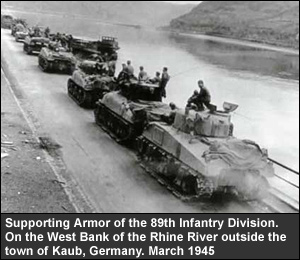 |
Rhine Crossing: The Attack of the 89th Division

The Division attacked at 0200, 26 March, the middle of the night, with two regiments in the assault (the 354th and 353rd) and one in reserve (355th).
The Attack of the 354th Infantry Regiment at Wellmich and St. Goarshausen: The 354th Infantry Regiment attacked across the river with 1st. Battalion attacking towards Wellmich and the 2nd. towards St. Goarshausen from St. Goar. Both attacks met strong resistance.
 Over a company and a half of 1st Battalion (Companies A and C) reached the east bank on the first wave. There was little resistance while crossing, but the men came under strong fire from the hillside behind Wellmich after getting ashore. Machine gun and 20 mm fire together with the swift current blocked their assault boats from returning to the west side – or any reinforcement. Prisoners taken here stated they had let the first wave get across easily, and then deliberately isolated it. Only after daylight could more infantry in strength be gotten across.
Over a company and a half of 1st Battalion (Companies A and C) reached the east bank on the first wave. There was little resistance while crossing, but the men came under strong fire from the hillside behind Wellmich after getting ashore. Machine gun and 20 mm fire together with the swift current blocked their assault boats from returning to the west side – or any reinforcement. Prisoners taken here stated they had let the first wave get across easily, and then deliberately isolated it. Only after daylight could more infantry in strength be gotten across.
Throughout the morning an intense effort by direct fire weapons (i.e. tank destroyer and machine guns against identified German machine gun and 20 mm gun positions), and a powerful, continuing concentration of artillery fire by eight Division and Corps battalions, made it possible to work more troops across. Also, heavy, continuing smoke concentrations on the east bank were employed to cut back visibility of the periodic waves of crossing assault craft. By 1400 hours all of 1st. Battalion was across. It moved on its initial objectives, the hill masses behind the Rhine. By darkness it had seized them, and gone well inland to take Weyer and Auel.
The problem was worse for 2nd battalion (354th Regt) - just to the north. It’s first wave (F and F Companies) attacked across the river from St. Goar at 0200, directly at the town of St. Goarshausen, a natural fortification The river is about 300 yards wide here. On the trip across they met point–blank, grazing fire just above the water from machine guns and 20 mm antiaircraft weapons The defenders had ignited a number of river barges on the St. Goarshausen side, thus lighting up the river clearly and the vulnerable assault boats on it Also, German artillery, mortar and 88mm fire fell on the west shore. There were no friendly artillery preparations for the attack was planned as a surprise. To this day, survivors recall this scene–as one from hell.
2nd. Battalion took casualties. Assault boats were smashed and sank, and numbers of men were killed, wounded or missing. More than a few were lost in the turbulent current. Survivors were lucky: many swam ashore or were picked up by other boats. (See story 1) The surprise is that so many men made it - getting ashore with their helmets, rifles and ammunition. Troops waiting to cross were driven behind walls and houses at St. Goar by the fire as they tried to deploy on the riverbank. Radio communications failed with the first wave on the east side, and only restored (with E Company) about 0430 that morning. The first wave of 2nd Battalion was cut off until well into the morning.
After daylight (as in 1st Battalion), visibility enabled direct fire weapons (such as tank destroyers) and artillery to identify German gun positions in St. Goarshausen and on the hillside behind - and knocked many of them out.
2nd Battalion crossings were resumed under powerful artillery support, together with the use of much smoke (as in 1st Battalion Zone). However, losses of men and equipment were unavoidable in the face of such a staunch defense. 2nd Battalion was across the Rhine intact by 1400 hours, providing the strength to clear St. Goarshausen during the afternoon. A growing number of prisoners accumulated at the water’s edge, awaiting transportation to move them to the west bank.
As darkness came down, 2nd Battalion had secured the steep hill mass east of St. Goarshausen, and that night, the 354th Regimental reserve (3rd Battalion), crossed the River under cover of darkness The Regiment was together on the east shore and progress had been made inland. Both landings were secure. The crust had been broken at Wellmich and St. Goarshausen.
Page 1 |
Page 2 | Page 3 |
Page 4 | Page 5 |
Page 6
|
 |

